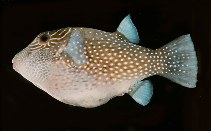| Family: |
Tetraodontidae (Puffers), subfamily: Canthigasterinae |
| Max. size: |
15 cm TL (male/unsexed) |
| Environment: |
reef-associated; marine; depth range 1 - 16 m |
| Distribution: |
Indo-Pacific: East Africa to the Galapagos Islands, north to southern Japan and Hawaii, south to the Great Barrier Reef and the Society Islands. |
| Diagnosis: |
Dorsal spines (total): 0-0; Dorsal soft rays (total): 10-12; Anal spines: 0-0; Anal soft rays: 10-11. Description: Characterized by brown to orange-brown color on forehead with bluish hue on ventral surface; head with dark brown to blue spots and bands; sides with small blue and blackish spots; depth of body at origin of anal fin 2.3-2.5 in SL; head length 2.4-2.9 in SL; snout length 1.4-1.6 in head length; bony interorbital width 2.6-2.9 in head length; caudal peduncle depth 2.0-2.5 in head length; slightly rounded caudal fin (Ref. 90102). |
| Biology: |
Inhabit shallow water, often subjected to surge. Juveniles secretive and remain in holes of outer reef flat and reef margin (Ref. 37816). Adults on shallow reef flats in high energy zones to about 10 meters depth. Juveniles among small boulders (Ref. 48637). Benthopelagic (Ref. 58302). Feed mainly on algae, but also takes polychaetes, sea urchins, brittle stars, mollusks, tunicates, corals, crustaceans and sponges. |
| IUCN Red List Status: |
Least Concern (LC); Date assessed: 07 June 2011 Ref. (130435)
|
| Threat to humans: |
harmless |
Source and more info: www.fishbase.org. For personal, classroom, and other internal use only. Not for publication.

